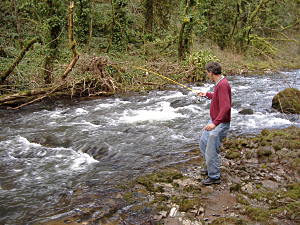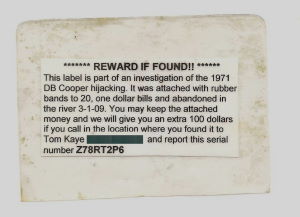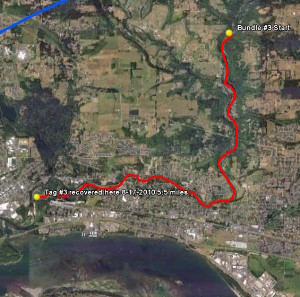|
Fact: The Washougal River basin is ten miles east of the FBI flight path map. Fact: The Washdown Theory requires that the bundles and rubber bands must stay intact over several years moving through rivers and ending up on Tena Bar. Experimental Fact: Tagged bundles of money wrapped with a rubber band were deployed along the Washougal River. One tag was recovered 18 months later, 5 miles downstream without the rubber band or money. |
|
The "Washougal Washdown Theory" started with Dr. Palmer's analysis that the money must have arrived at Tena Bar after the 1974 dredging. The common theory at the time was that Cooper died in the jump, so this suggested that the money must have been transported over the previous three years to a point upstream in the Columbia by natural causes. Subsequent analysis of the terrain, showed that the only river large enough that came from the general area where Cooper jumped, and fed into the Columbia River upstream from Tena Bar, was the Washougal River. The Washougal River is average size with rapids and quiet water stretches. Reports from people searching this area for Cooper clues indicate that flooding in the winter increases the water flow several fold [1]. Experiments were designed to determine the potential for the river to move bundles of money downstream. Methods Experiment # 1, a bundle of one hundred, one dollar bills wrapped in a rubber band was attached to the line on a fishing pole (Fig. 1). A fast flowing part of the river was sought out and the bundle was dispensed into the water and tracked in the flow. The bundle traveled along the bottom and was discharged into quiet water where it sank to the bottom and did not move. This was repeated several times with similar results. Experiment # 2, three individual bundles of twenty, one dollar bills with a reward note attached (Fig. 2) were bound with rubber bands similar to the ones available to banks in 1971. Each bundle had a unique serial number Google Earth was used to outline the Washougal River and tributaries to determine its closest proximity to Ariel Washington, where records indicated Cooper bailed out. This provided no simple way to overlay the Washougal theory with Cooper's reported jump zone. Discussion The fishing pole experiment showed that at high flow rates, the river was capable of moving bundles of money. However, the morphology of the river bottom opened up into deeper slow moving shallow areas with many large rocks on the bottom. The river also was in a heavily forested area and many trees that had fallen into the river offered potential for snags. One bundle was searched for a couple months later and was reported as having traveled about 100 yards down stream [1]. The fishing pole experiment did not reliably indicate if the bundle of money could move large distances down stream or not. One of the deployed bundles had it's note recovered by a member of the public eighteen months after release (Fig. 2). The rubber bands and money had become separated from the tag and were not recovered. The tag was recovered in a shallow water area close to the mouth of the Columbia after traveling 5.5 miles (Fig. 3). The bundle did not survive the trip intact, suggesting that the rubber bands degraded and came loose over this time period which is considerably less than the 3-4 years required for the Washdown Theory. Google Earth analysis of the Washougal Basin showed that at no point is any of the Washougal River or its tributaries closer than twenty miles from Ariel, Washington. This provided no overlap between Cooper's reported jump zone and the Washougal theory. Conclusions The Washougal River does have some ability to move objects like a bundle of money down stream For the Washougal Washdown Theory to be credible, several actions must take place to have the Cooper bundles arrive on Tena Bar some time after 1974. The plane had to be a considerable distance east of the published flight path. The rubber bands surviving four years during their trip down river is not supported by the experimental data shown here with the recovered tag, and in the rubber band analysis. The bills were still in relative alignment when found on Tena Bar which seems implausible along with the fact they stayed together, if they went through a dredging and subsequent bulldozing operation. All the data on the flight path from both civilian and military sources does not provide any evidence that the plane was as far east as the Washougal River Basin. The basis for this theory is primarily based on the Palmer Report without additional supporting evidence. The Washdown Theory under close examination does not provide any plausible explanations for the facts surrounding the Cooper Skyjacking. References 1. Personal communication, Jerry Thomas: Mr. Thomas has spent years searching the Washougal watershed for evidence of Cooper. |


